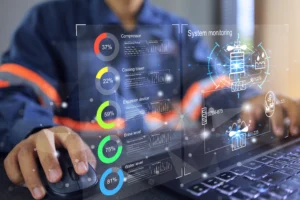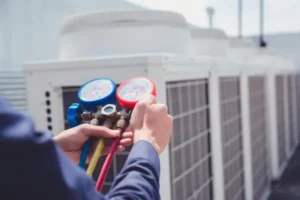Navigating the Next Generation of Commercial HVAC
The commercial HVAC industry is rapidly adapting to new market demands, evolving technologies, and shifting regulatory landscapes. As we move deeper into 2025, building owners, facilities managers, and industry professionals must stay informed of the latest trends and developments to ensure efficient, compliant, and future-proof HVAC strategies. Building upon key areas we identified last year, this article delves into the critical commercial HVAC trends shaping 2025, including the significant shift towards electrification, the impending refrigerant transition, and the ongoing pursuit of energy optimization. Below, we explore key trends influencing commercial HVAC in 2025 and practical steps to navigate these changes.
Electrification and Heat Pump Technologies
Electrification continues to be a major trend in commercial HVAC, driven by sustainability goals, regulatory requirements, and cost efficiency. All-electric heat pump systems, particularly Variable Refrigerant Flow (VRF) technologies, have become increasingly popular due to their ability to efficiently manage diverse heating and cooling needs across multiple building zones. These systems offer:
- Precise temperature control tailored to occupancy and usage
- Improved energy efficiency compared to traditional HVAC systems
- Enhanced compatibility with renewable energy sources
Facilities managers are increasingly opting for VRF systems in environments like multi-family housing, educational institutions, healthcare facilities, and offices, recognizing their superior performance in energy conservation and occupant comfort. While our 2024 trends discussion highlighted the growing demand for broader sustainable solutions, the focus in 2025 is intensifying around the implementation of electrification and advanced heat pump technologies as a core pathway to achieving those goals.
Refrigerant Transition: Preparing for Low-GWP Refrigerants
With the American Innovation and Manufacturing (AIM) Act mandating the use of low Global Warming Potential (GWP) refrigerants for new commercial refrigeration systems by January 2026, HVAC professionals must be proactive in their transition strategies. Key considerations include:
- Understanding the characteristics and handling requirements of new refrigerants such as R-454B and R-32, categorized as A2L refrigerants due to their mild flammability.
- Ensuring adherence to updated safety standards, including enhanced leak detection and ventilation requirements.
- Strategic planning for equipment inventory and supply management to avoid disruptions as the transition deadline approaches.
While the EPA is currently reconsidering some aspects of the AIM Act implementation timeline, the refrigerant transition represents a significant shift, and facilities would be wise to plan well ahead to ensure compliance and operational continuity.
Energy Optimization and Decarbonization
Commercial buildings are increasingly pursuing strategies for energy optimization and carbon reduction to meet both regulatory mandates and sustainability goals. Practical steps toward decarbonization include:
- Comprehensive energy audits and mechanical system assessments
- Advanced thermal performance analyses (heat loss and gain assessments)
- Strategic implementation of renewable energy systems and high-efficiency HVAC equipment
These proactive measures not only enhance building sustainability but also significantly reduce operating costs through improved energy efficiency. The ability to make data-driven decisions for optimizing HVAC performance, a key trend in 2024, is now central to achieving comprehensive energy optimization and decarbonization in 2025.
Strategic Capital Planning
Forward-thinking organizations are increasingly recognizing the value of long-term capital infrastructure planning for HVAC. Strategic capital planning involves:
- Developing phased infrastructure investment plans to manage costs effectively
- Identifying priority upgrades and replacements aligned with regulatory timelines and sustainability targets
- Planning for resilience to maintain operations through future regulatory or market-driven changes
Recent tariff changes may impact HVAC equipment and component costs, further highlighting the need for careful budgeting and strategic procurement.
Staying Ahead of the Curve
Given the dynamic nature of the commercial HVAC industry, staying informed and adaptable is essential. By closely tracking evolving technologies, preparing early for regulatory changes, and adopting best practices in maintenance and infrastructure planning, facilities managers can effectively position their buildings for sustained success, efficiency, and compliance well into the future. The continued importance of Indoor Air Quality (IAQ), a key focus in 2024, underpins many of these advancements for healthier buildings.



